Abstract
Free radicals and other reactive oxygen species (ROS) are constantly formed in the human body, often for useful metabolic purposes. Antioxidant defenses protect against them, but these defenses are not completely adequate, and systems that repair damage by ROS are also necessary. Mild oxidative stress often induces antioxidant defense enzymes, but severe stress can cause oxidative damage to lipids, proteins, and DNA within cells, leading to such events as DNA strand breakage and disruption of calcium ion metabolism. Oxidative stress can result from exposure to toxic agents, and by the process of tissue injury itself. Ozone, oxides of nitrogen, and cigarette smoke can cause oxidative damage; but the molecular targets that they damage may not be the same.
Full text
PDF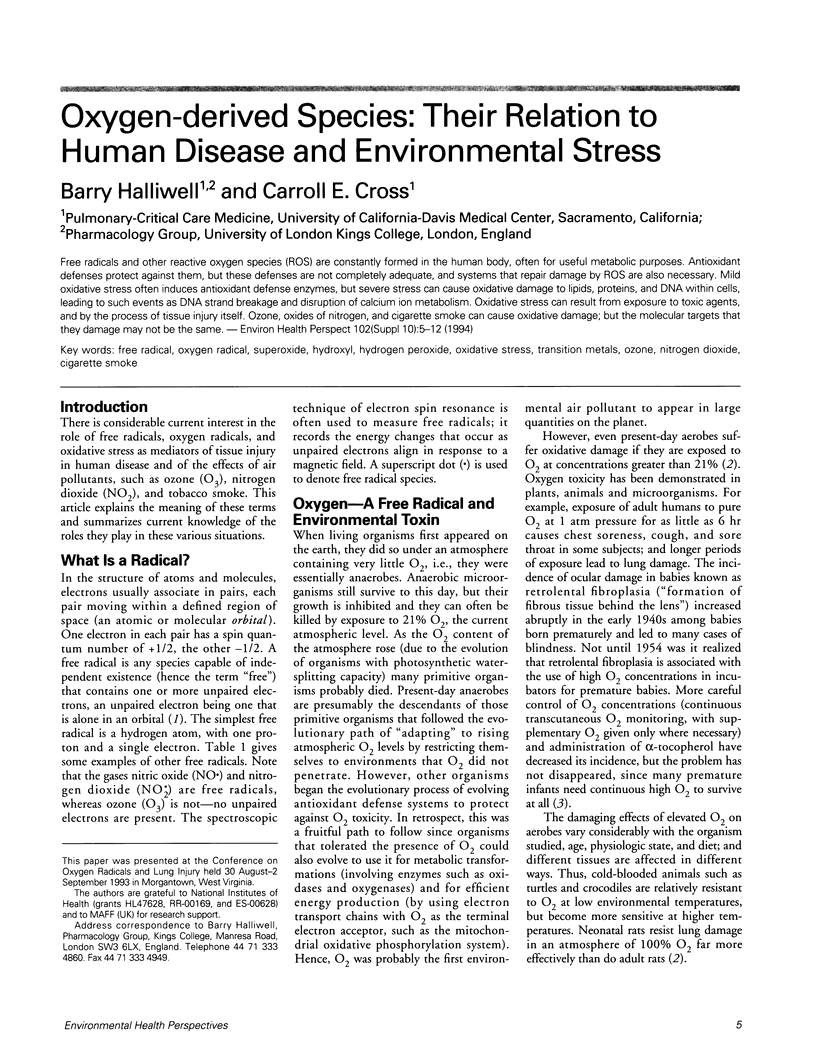
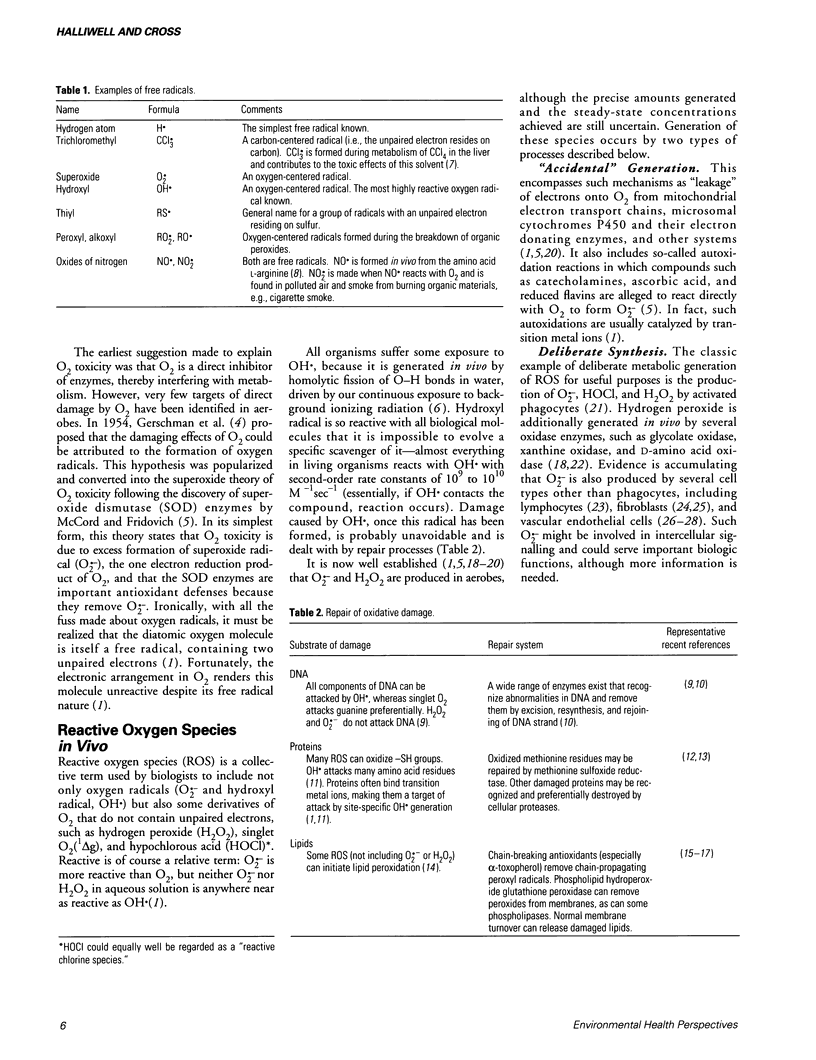
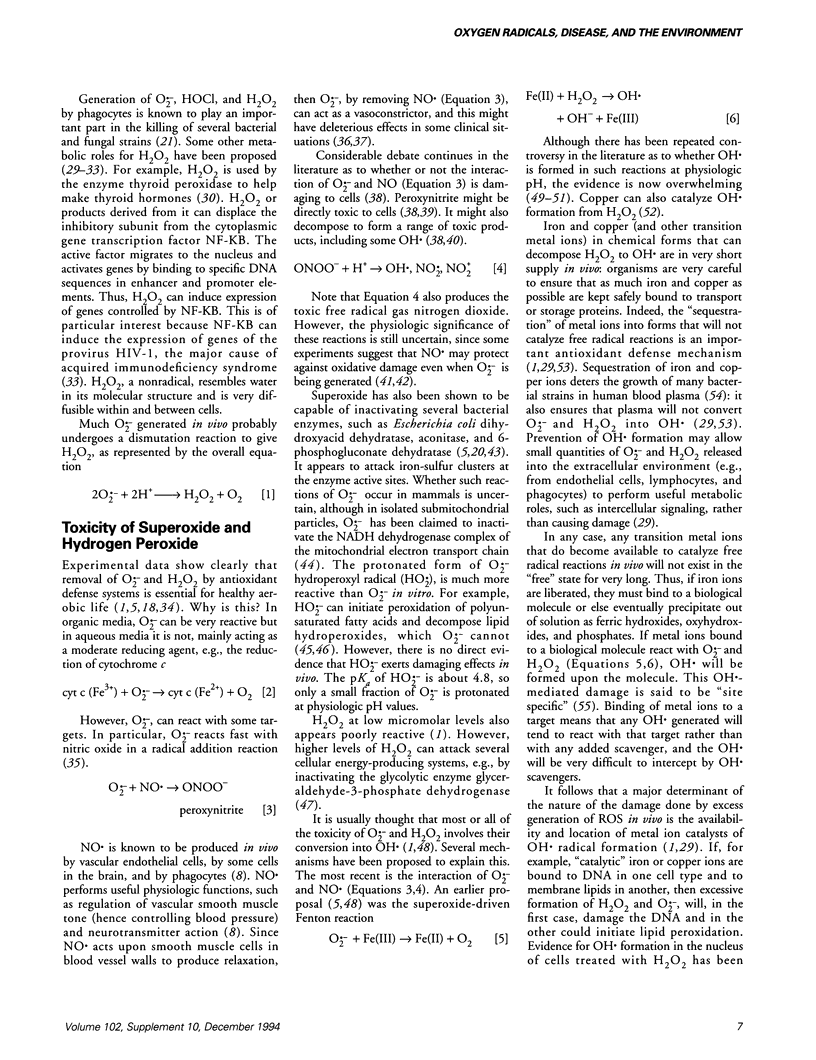

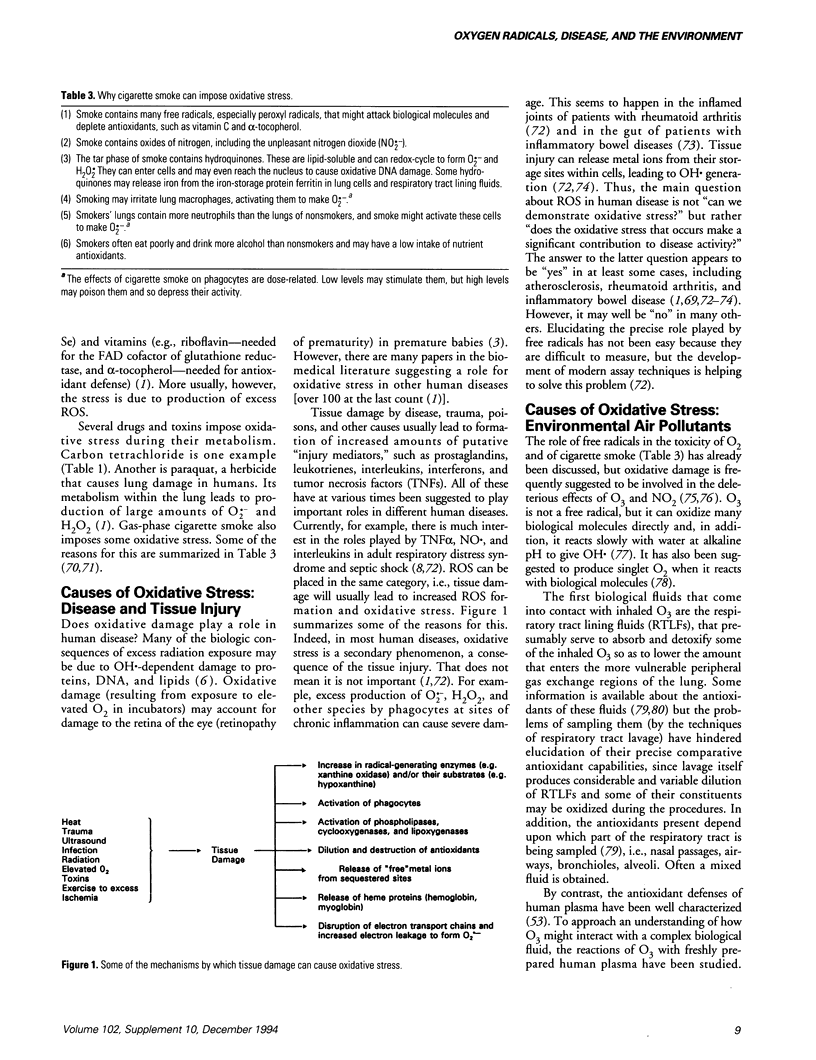
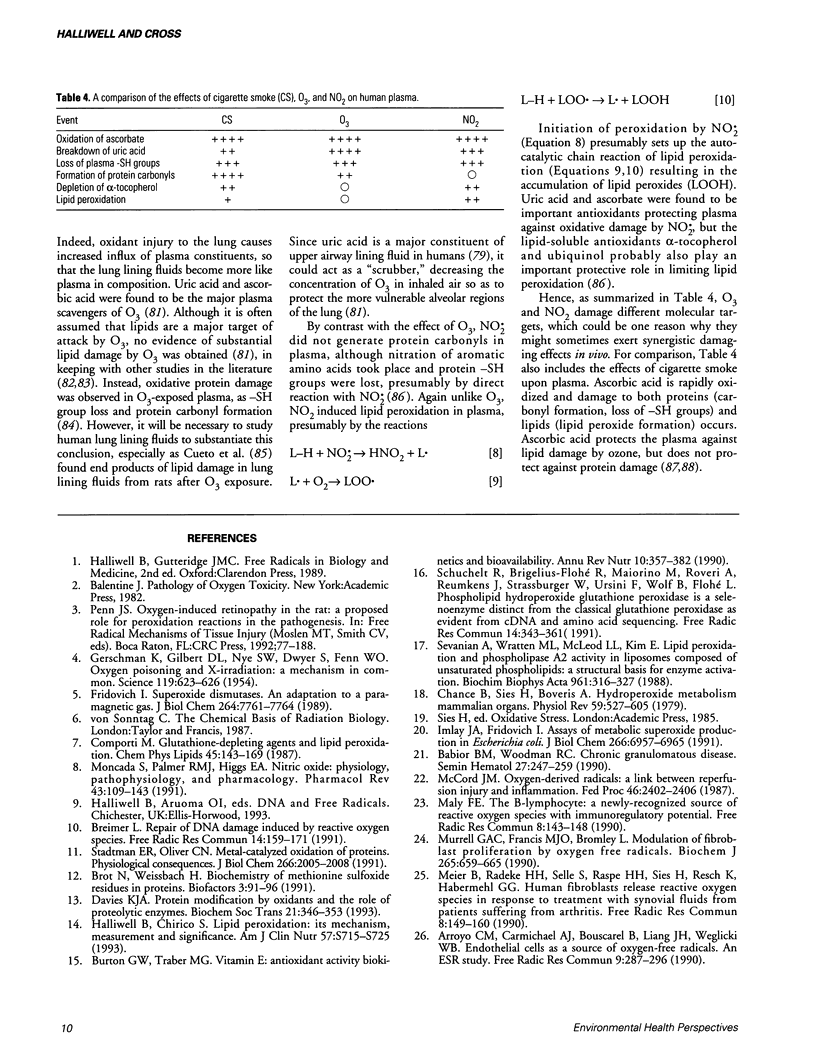
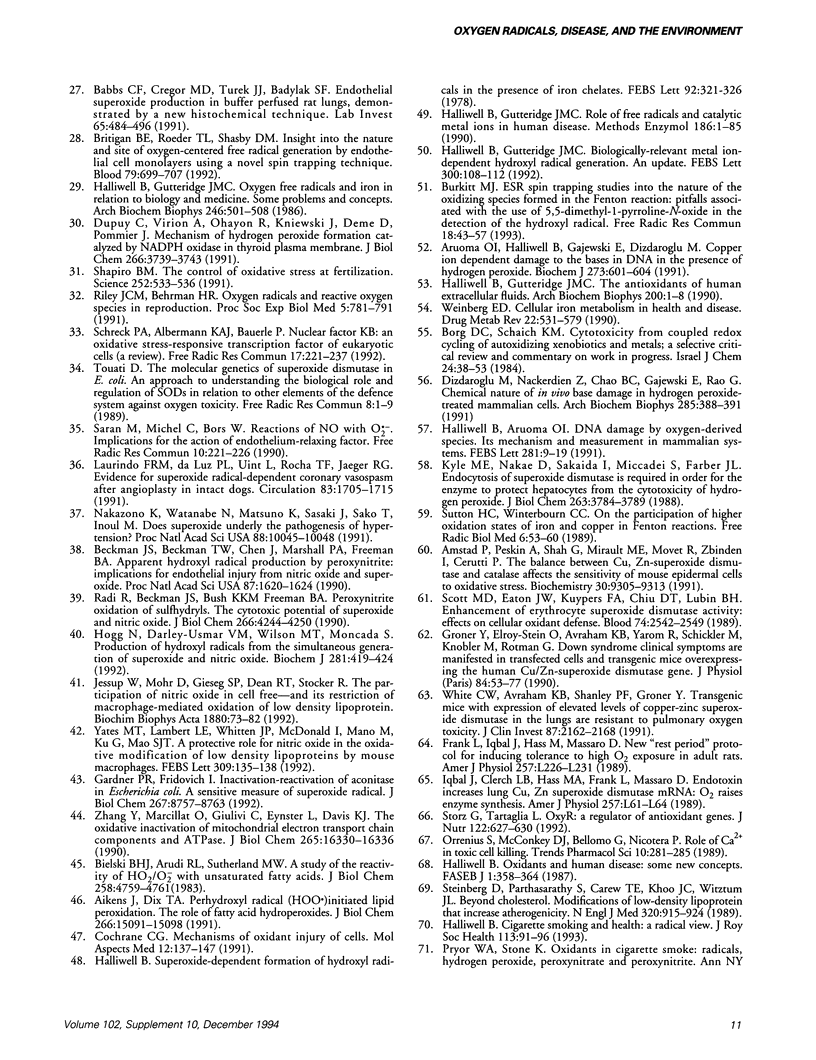
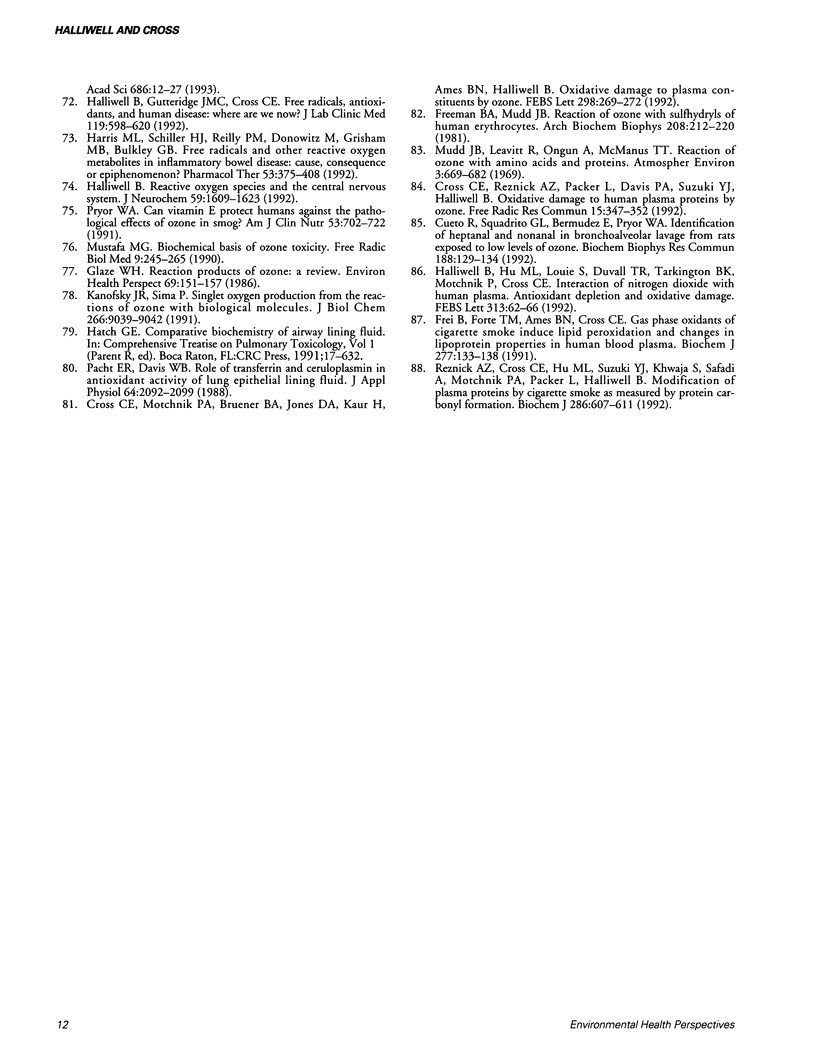
Selected References
These references are in PubMed. This may not be the complete list of references from this article.
- Aikens J., Dix T. A. Perhydroxyl radical (HOO.) initiated lipid peroxidation. The role of fatty acid hydroperoxides. J Biol Chem. 1991 Aug 15;266(23):15091–15098. [PubMed] [Google Scholar]
- Amstad P., Peskin A., Shah G., Mirault M. E., Moret R., Zbinden I., Cerutti P. The balance between Cu,Zn-superoxide dismutase and catalase affects the sensitivity of mouse epidermal cells to oxidative stress. Biochemistry. 1991 Sep 24;30(38):9305–9313. doi: 10.1021/bi00102a024. [DOI] [PubMed] [Google Scholar]
- Arroyo C. M., Carmichael A. J., Bouscarel B., Liang J. H., Weglicki W. B. Endothelial cells as a source of oxygen-free radicals. An ESR study. Free Radic Res Commun. 1990;9(3-6):287–296. doi: 10.3109/10715769009145687. [DOI] [PubMed] [Google Scholar]
- Aruoma O. I., Halliwell B., Gajewski E., Dizdaroglu M. Copper-ion-dependent damage to the bases in DNA in the presence of hydrogen peroxide. Biochem J. 1991 Feb 1;273(Pt 3):601–604. doi: 10.1042/bj2730601. [DOI] [PMC free article] [PubMed] [Google Scholar]
- Babbs C. F., Cregor M. D., Turek J. J., Badylak S. F. Endothelial superoxide production in buffer perfused rat lungs, demonstrated by a new histochemical technique. Lab Invest. 1991 Oct;65(4):484–496. [PubMed] [Google Scholar]
- Babior B. M., Woodman R. C. Chronic granulomatous disease. Semin Hematol. 1990 Jul;27(3):247–259. [PubMed] [Google Scholar]
- Beckman J. S., Beckman T. W., Chen J., Marshall P. A., Freeman B. A. Apparent hydroxyl radical production by peroxynitrite: implications for endothelial injury from nitric oxide and superoxide. Proc Natl Acad Sci U S A. 1990 Feb;87(4):1620–1624. doi: 10.1073/pnas.87.4.1620. [DOI] [PMC free article] [PubMed] [Google Scholar]
- Bielski B. H., Arudi R. L., Sutherland M. W. A study of the reactivity of HO2/O2- with unsaturated fatty acids. J Biol Chem. 1983 Apr 25;258(8):4759–4761. [PubMed] [Google Scholar]
- Breimer L. H. Repair of DNA damage induced by reactive oxygen species. Free Radic Res Commun. 1991;14(3):159–171. doi: 10.3109/10715769109088945. [DOI] [PubMed] [Google Scholar]
- Britigan B. E., Roeder T. L., Shasby D. M. Insight into the nature and site of oxygen-centered free radical generation by endothelial cell monolayers using a novel spin trapping technique. Blood. 1992 Feb 1;79(3):699–707. [PubMed] [Google Scholar]
- Brot N., Weissbach H. Biochemistry of methionine sulfoxide residues in proteins. Biofactors. 1991 Jun;3(2):91–96. [PubMed] [Google Scholar]
- Burkitt M. J. ESR spin trapping studies into the nature of the oxidizing species formed in the Fenton reaction: pitfalls associated with the use of 5,5-dimethyl-1-pyrroline-N-oxide in the detection of the hydroxyl radical. Free Radic Res Commun. 1993;18(1):43–57. doi: 10.3109/10715769309149912. [DOI] [PubMed] [Google Scholar]
- Burton G. W., Traber M. G. Vitamin E: antioxidant activity, biokinetics, and bioavailability. Annu Rev Nutr. 1990;10:357–382. doi: 10.1146/annurev.nu.10.070190.002041. [DOI] [PubMed] [Google Scholar]
- Chance B., Sies H., Boveris A. Hydroperoxide metabolism in mammalian organs. Physiol Rev. 1979 Jul;59(3):527–605. doi: 10.1152/physrev.1979.59.3.527. [DOI] [PubMed] [Google Scholar]
- Cochrane C. G. Mechanisms of oxidant injury of cells. Mol Aspects Med. 1991;12(2):137–147. doi: 10.1016/0098-2997(91)90009-b. [DOI] [PubMed] [Google Scholar]
- Comporti M. Glutathione depleting agents and lipid peroxidation. Chem Phys Lipids. 1987 Nov-Dec;45(2-4):143–169. doi: 10.1016/0009-3084(87)90064-8. [DOI] [PubMed] [Google Scholar]
- Cross C. E., Motchnik P. A., Bruener B. A., Jones D. A., Kaur H., Ames B. N., Halliwell B. Oxidative damage to plasma constituents by ozone. FEBS Lett. 1992 Feb 24;298(2-3):269–272. doi: 10.1016/0014-5793(92)80074-q. [DOI] [PubMed] [Google Scholar]
- Cross C. E., Reznick A. Z., Packer L., Davis P. A., Suzuki Y. J., Halliwell B. Oxidative damage to human plasma proteins by ozone. Free Radic Res Commun. 1992;15(6):347–352. doi: 10.3109/10715769209049150. [DOI] [PubMed] [Google Scholar]
- Cueto R., Squadrito G. L., Bermudez E., Pryor W. A. Identification of heptanal and nonanal in bronchoalveolar lavage from rats exposed to low levels of ozone. Biochem Biophys Res Commun. 1992 Oct 15;188(1):129–134. doi: 10.1016/0006-291x(92)92359-6. [DOI] [PubMed] [Google Scholar]
- Davies K. J. Protein modification by oxidants and the role of proteolytic enzymes. Biochem Soc Trans. 1993 May;21(2):346–353. doi: 10.1042/bst0210346. [DOI] [PubMed] [Google Scholar]
- Dizdaroglu M., Nackerdien Z., Chao B. C., Gajewski E., Rao G. Chemical nature of in vivo DNA base damage in hydrogen peroxide-treated mammalian cells. Arch Biochem Biophys. 1991 Mar;285(2):388–390. doi: 10.1016/0003-9861(91)90378-v. [DOI] [PubMed] [Google Scholar]
- Dupuy C., Virion A., Ohayon R., Kaniewski J., Dème D., Pommier J. Mechanism of hydrogen peroxide formation catalyzed by NADPH oxidase in thyroid plasma membrane. J Biol Chem. 1991 Feb 25;266(6):3739–3743. [PubMed] [Google Scholar]
- Frank L., Iqbal J., Hass M., Massaro D. New "rest period" protocol for inducing tolerance to high O2 exposure in adult rats. Am J Physiol. 1989 Oct;257(4 Pt 1):L226–L231. doi: 10.1152/ajplung.1989.257.4.L226. [DOI] [PubMed] [Google Scholar]
- Freeman B. A., Mudd J. B. Reaction of ozone with sulfhydryls of human erythrocytes. Arch Biochem Biophys. 1981 Apr 15;208(1):212–220. doi: 10.1016/0003-9861(81)90142-9. [DOI] [PubMed] [Google Scholar]
- Frei B., Forte T. M., Ames B. N., Cross C. E. Gas phase oxidants of cigarette smoke induce lipid peroxidation and changes in lipoprotein properties in human blood plasma. Protective effects of ascorbic acid. Biochem J. 1991 Jul 1;277(Pt 1):133–138. doi: 10.1042/bj2770133. [DOI] [PMC free article] [PubMed] [Google Scholar]
- Fridovich I. Superoxide dismutases. An adaptation to a paramagnetic gas. J Biol Chem. 1989 May 15;264(14):7761–7764. [PubMed] [Google Scholar]
- GERSCHMAN R., GILBERT D. L., NYE S. W., DWYER P., FENN W. O. Oxygen poisoning and x-irradiation: a mechanism in common. Science. 1954 May 7;119(3097):623–626. doi: 10.1126/science.119.3097.623. [DOI] [PubMed] [Google Scholar]
- Gardner P. R., Fridovich I. Inactivation-reactivation of aconitase in Escherichia coli. A sensitive measure of superoxide radical. J Biol Chem. 1992 May 5;267(13):8757–8763. [PubMed] [Google Scholar]
- Glaze W. H. Reaction products of ozone: a review. Environ Health Perspect. 1986 Nov;69:151–157. doi: 10.1289/ehp.8669151. [DOI] [PMC free article] [PubMed] [Google Scholar]
- Groner Y., Elroy-Stein O., Avraham K. B., Yarom R., Schickler M., Knobler H., Rotman G. Down syndrome clinical symptoms are manifested in transfected cells and transgenic mice overexpressing the human Cu/Zn-superoxide dismutase gene. J Physiol (Paris) 1990;84(1):53–77. [PubMed] [Google Scholar]
- Halliwell B., Aruoma O. I. DNA damage by oxygen-derived species. Its mechanism and measurement in mammalian systems. FEBS Lett. 1991 Apr 9;281(1-2):9–19. doi: 10.1016/0014-5793(91)80347-6. [DOI] [PubMed] [Google Scholar]
- Halliwell B. Cigarette smoking and health: a radical view. J R Soc Health. 1993 Apr;113(2):91–96. doi: 10.1177/146642409311300209. [DOI] [PubMed] [Google Scholar]
- Halliwell B., Gutteridge J. M. Biologically relevant metal ion-dependent hydroxyl radical generation. An update. FEBS Lett. 1992 Jul 27;307(1):108–112. doi: 10.1016/0014-5793(92)80911-y. [DOI] [PubMed] [Google Scholar]
- Halliwell B., Gutteridge J. M., Cross C. E. Free radicals, antioxidants, and human disease: where are we now? J Lab Clin Med. 1992 Jun;119(6):598–620. [PubMed] [Google Scholar]
- Halliwell B., Gutteridge J. M. Oxygen free radicals and iron in relation to biology and medicine: some problems and concepts. Arch Biochem Biophys. 1986 May 1;246(2):501–514. doi: 10.1016/0003-9861(86)90305-x. [DOI] [PubMed] [Google Scholar]
- Halliwell B., Gutteridge J. M. Role of free radicals and catalytic metal ions in human disease: an overview. Methods Enzymol. 1990;186:1–85. doi: 10.1016/0076-6879(90)86093-b. [DOI] [PubMed] [Google Scholar]
- Halliwell B., Gutteridge J. M. The antioxidants of human extracellular fluids. Arch Biochem Biophys. 1990 Jul;280(1):1–8. doi: 10.1016/0003-9861(90)90510-6. [DOI] [PubMed] [Google Scholar]
- Halliwell B., Hu M. L., Louie S., Duvall T. R., Tarkington B. K., Motchnik P., Cross C. E. Interaction of nitrogen dioxide with human plasma. Antioxidant depletion and oxidative damage. FEBS Lett. 1992 Nov 16;313(1):62–66. doi: 10.1016/0014-5793(92)81185-o. [DOI] [PubMed] [Google Scholar]
- Halliwell B. Oxidants and human disease: some new concepts. FASEB J. 1987 Nov;1(5):358–364. [PubMed] [Google Scholar]
- Halliwell B. Reactive oxygen species and the central nervous system. J Neurochem. 1992 Nov;59(5):1609–1623. doi: 10.1111/j.1471-4159.1992.tb10990.x. [DOI] [PubMed] [Google Scholar]
- Halliwell B. Superoxide-dependent formation of hydroxyl radicals in the presence of iron chelates: is it a mechanism for hydroxyl radical production in biochemical systems? FEBS Lett. 1978 Aug 15;92(2):321–326. doi: 10.1016/0014-5793(78)80779-0. [DOI] [PubMed] [Google Scholar]
- Harris M. L., Schiller H. J., Reilly P. M., Donowitz M., Grisham M. B., Bulkley G. B. Free radicals and other reactive oxygen metabolites in inflammatory bowel disease: cause, consequence or epiphenomenon? Pharmacol Ther. 1992;53(3):375–408. doi: 10.1016/0163-7258(92)90057-7. [DOI] [PubMed] [Google Scholar]
- Hogg N., Darley-Usmar V. M., Wilson M. T., Moncada S. Production of hydroxyl radicals from the simultaneous generation of superoxide and nitric oxide. Biochem J. 1992 Jan 15;281(Pt 2):419–424. doi: 10.1042/bj2810419. [DOI] [PMC free article] [PubMed] [Google Scholar]
- Imlay J. A., Fridovich I. Assay of metabolic superoxide production in Escherichia coli. J Biol Chem. 1991 Apr 15;266(11):6957–6965. [PubMed] [Google Scholar]
- Iqbal J., Clerch L. B., Hass M. A., Frank L., Massaro D. Endotoxin increases lung Cu,Zn superoxide dismutase mRNA: O2 raises enzyme synthesis. Am J Physiol. 1989 Aug;257(2 Pt 1):L61–L64. doi: 10.1152/ajplung.1989.257.2.L61. [DOI] [PubMed] [Google Scholar]
- Jessup W., Mohr D., Gieseg S. P., Dean R. T., Stocker R. The participation of nitric oxide in cell free- and its restriction of macrophage-mediated oxidation of low-density lipoprotein. Biochim Biophys Acta. 1992 Oct 13;1180(1):73–82. doi: 10.1016/0925-4439(92)90029-m. [DOI] [PubMed] [Google Scholar]
- Kanofsky J. R., Sima P. Singlet oxygen production from the reactions of ozone with biological molecules. J Biol Chem. 1991 May 15;266(14):9039–9042. [PubMed] [Google Scholar]
- Kyle M. E., Nakae D., Sakaida I., Miccadei S., Farber J. L. Endocytosis of superoxide dismutase is required in order for the enzyme to protect hepatocytes from the cytotoxicity of hydrogen peroxide. J Biol Chem. 1988 Mar 15;263(8):3784–3789. [PubMed] [Google Scholar]
- Laurindo F. R., da Luz P. L., Uint L., Rocha T. F., Jaeger R. G., Lopes E. A. Evidence for superoxide radical-dependent coronary vasospasm after angioplasty in intact dogs. Circulation. 1991 May;83(5):1705–1715. doi: 10.1161/01.cir.83.5.1705. [DOI] [PubMed] [Google Scholar]
- Maly F. E. The B lymphocyte: a newly recognized source of reactive oxygen species with immunoregulatory potential. Free Radic Res Commun. 1990;8(3):143–148. doi: 10.3109/10715769009087987. [DOI] [PubMed] [Google Scholar]
- McCord J. M. Oxygen-derived radicals: a link between reperfusion injury and inflammation. Fed Proc. 1987 May 15;46(7):2402–2406. [PubMed] [Google Scholar]
- Meier B., Radeke H. H., Selle S., Raspe H. H., Sies H., Resch K., Habermehl G. G. Human fibroblasts release reactive oxygen species in response to treatment with synovial fluids from patients suffering from arthritis. Free Radic Res Commun. 1990;8(3):149–160. doi: 10.3109/10715769009087988. [DOI] [PubMed] [Google Scholar]
- Moncada S., Palmer R. M., Higgs E. A. Nitric oxide: physiology, pathophysiology, and pharmacology. Pharmacol Rev. 1991 Jun;43(2):109–142. [PubMed] [Google Scholar]
- Mudd J. B., Leavitt R., Ongun A., McManus T. T. Reaction of ozone with amino acids and proteins. Atmos Environ. 1969 Nov;3(6):669–682. doi: 10.1016/0004-6981(69)90024-9. [DOI] [PubMed] [Google Scholar]
- Murrell G. A., Francis M. J., Bromley L. Modulation of fibroblast proliferation by oxygen free radicals. Biochem J. 1990 Feb 1;265(3):659–665. doi: 10.1042/bj2650659. [DOI] [PMC free article] [PubMed] [Google Scholar]
- Mustafa M. G. Biochemical basis of ozone toxicity. Free Radic Biol Med. 1990;9(3):245–265. doi: 10.1016/0891-5849(90)90035-h. [DOI] [PubMed] [Google Scholar]
- Nakazono K., Watanabe N., Matsuno K., Sasaki J., Sato T., Inoue M. Does superoxide underlie the pathogenesis of hypertension? Proc Natl Acad Sci U S A. 1991 Nov 15;88(22):10045–10048. doi: 10.1073/pnas.88.22.10045. [DOI] [PMC free article] [PubMed] [Google Scholar]
- Orrenius S., McConkey D. J., Bellomo G., Nicotera P. Role of Ca2+ in toxic cell killing. Trends Pharmacol Sci. 1989 Jul;10(7):281–285. doi: 10.1016/0165-6147(89)90029-1. [DOI] [PubMed] [Google Scholar]
- Pacht E. R., Davis W. B. Role of transferrin and ceruloplasmin in antioxidant activity of lung epithelial lining fluid. J Appl Physiol (1985) 1988 May;64(5):2092–2099. doi: 10.1152/jappl.1988.64.5.2092. [DOI] [PubMed] [Google Scholar]
- Pryor W. A. Can vitamin E protect humans against the pathological effects of ozone in smog? Am J Clin Nutr. 1991 Mar;53(3):702–722. doi: 10.1093/ajcn/53.3.702. [DOI] [PubMed] [Google Scholar]
- Radi R., Beckman J. S., Bush K. M., Freeman B. A. Peroxynitrite oxidation of sulfhydryls. The cytotoxic potential of superoxide and nitric oxide. J Biol Chem. 1991 Mar 5;266(7):4244–4250. [PubMed] [Google Scholar]
- Reznick A. Z., Cross C. E., Hu M. L., Suzuki Y. J., Khwaja S., Safadi A., Motchnik P. A., Packer L., Halliwell B. Modification of plasma proteins by cigarette smoke as measured by protein carbonyl formation. Biochem J. 1992 Sep 1;286(Pt 2):607–611. doi: 10.1042/bj2860607. [DOI] [PMC free article] [PubMed] [Google Scholar]
- Riley J. C., Behrman H. R. Oxygen radicals and reactive oxygen species in reproduction. Proc Soc Exp Biol Med. 1991 Dec;198(3):781–791. doi: 10.3181/00379727-198-43321c. [DOI] [PubMed] [Google Scholar]
- Saran M., Michel C., Bors W. Reaction of NO with O2-. implications for the action of endothelium-derived relaxing factor (EDRF). Free Radic Res Commun. 1990;10(4-5):221–226. doi: 10.3109/10715769009149890. [DOI] [PubMed] [Google Scholar]
- Schreck R., Albermann K., Baeuerle P. A. Nuclear factor kappa B: an oxidative stress-responsive transcription factor of eukaryotic cells (a review). Free Radic Res Commun. 1992;17(4):221–237. doi: 10.3109/10715769209079515. [DOI] [PubMed] [Google Scholar]
- Schuckelt R., Brigelius-Flohé R., Maiorino M., Roveri A., Reumkens J., Strassburger W., Ursini F., Wolf B., Flohé L. Phospholipid hydroperoxide glutathione peroxidase is a selenoenzyme distinct from the classical glutathione peroxidase as evident from cDNA and amino acid sequencing. Free Radic Res Commun. 1991;14(5-6):343–361. doi: 10.3109/10715769109093424. [DOI] [PubMed] [Google Scholar]
- Scott M. D., Eaton J. W., Kuypers F. A., Chiu D. T., Lubin B. H. Enhancement of erythrocyte superoxide dismutase activity: effects on cellular oxidant defense. Blood. 1989 Nov 15;74(7):2542–2549. [PubMed] [Google Scholar]
- Sevanian A., Wratten M. L., McLeod L. L., Kim E. Lipid peroxidation and phospholipase A2 activity in liposomes composed of unsaturated phospholipids: a structural basis for enzyme activation. Biochim Biophys Acta. 1988 Aug 12;961(3):316–327. doi: 10.1016/0005-2760(88)90079-3. [DOI] [PubMed] [Google Scholar]
- Shapiro B. M. The control of oxidant stress at fertilization. Science. 1991 Apr 26;252(5005):533–536. doi: 10.1126/science.1850548. [DOI] [PubMed] [Google Scholar]
- Stadtman E. R., Oliver C. N. Metal-catalyzed oxidation of proteins. Physiological consequences. J Biol Chem. 1991 Feb 5;266(4):2005–2008. [PubMed] [Google Scholar]
- Steinberg D., Parthasarathy S., Carew T. E., Khoo J. C., Witztum J. L. Beyond cholesterol. Modifications of low-density lipoprotein that increase its atherogenicity. N Engl J Med. 1989 Apr 6;320(14):915–924. doi: 10.1056/NEJM198904063201407. [DOI] [PubMed] [Google Scholar]
- Storz G., Tartaglia L. A. OxyR: a regulator of antioxidant genes. J Nutr. 1992 Mar;122(3 Suppl):627–630. doi: 10.1093/jn/122.suppl_3.627. [DOI] [PubMed] [Google Scholar]
- Sutton H. C., Winterbourn C. C. On the participation of higher oxidation states of iron and copper in Fenton reactions. Free Radic Biol Med. 1989;6(1):53–60. doi: 10.1016/0891-5849(89)90160-3. [DOI] [PubMed] [Google Scholar]
- Touati D. The molecular genetics of superoxide dismutase in E. coli. An approach to understanding the biological role and regulation of SODS in relation to other elements of the defence system against oxygen toxicity. Free Radic Res Commun. 1989;8(1):1–9. doi: 10.3109/10715768909087967. [DOI] [PubMed] [Google Scholar]
- Weinberg E. D. Cellular iron metabolism in health and disease. Drug Metab Rev. 1990;22(5):531–579. doi: 10.3109/03602539008991450. [DOI] [PubMed] [Google Scholar]
- White C. W., Avraham K. B., Shanley P. F., Groner Y. Transgenic mice with expression of elevated levels of copper-zinc superoxide dismutase in the lungs are resistant to pulmonary oxygen toxicity. J Clin Invest. 1991 Jun;87(6):2162–2168. doi: 10.1172/JCI115249. [DOI] [PMC free article] [PubMed] [Google Scholar]
- Yates M. T., Lambert L. E., Whitten J. P., McDonald I., Mano M., Ku G., Mao S. J. A protective role for nitric oxide in the oxidative modification of low density lipoproteins by mouse macrophages. FEBS Lett. 1992 Sep 7;309(2):135–138. doi: 10.1016/0014-5793(92)81081-v. [DOI] [PubMed] [Google Scholar]
- Zhang Y., Marcillat O., Giulivi C., Ernster L., Davies K. J. The oxidative inactivation of mitochondrial electron transport chain components and ATPase. J Biol Chem. 1990 Sep 25;265(27):16330–16336. [PubMed] [Google Scholar]


